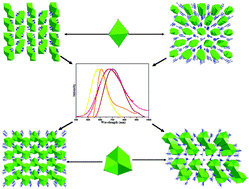Organic cation directed hybrid lead halides of zero-dimensional to two-dimensional structures with tunable photoluminescence properties†
Abstract
Recently, organic–inorganic hybrid lead halides have been explored as photoluminescent (PL) materials with flexible structural tunabilities and high photoluminescence quantum efficiencies, which can be modified by the structure regulating functions of organic cations. Here, by adopting different saturated organic cations as structure directing agents (SDAs), a series of organic–inorganic hybrid lead halides have been solvothermally synthesized and characterized with different structural types. Compound [(CH3)2NH2]2[H2DABCO]2Pb3I12 (1, DABCO = 1,4-diazabicyclo[2.2.2]-octane) features a linear zero-dimensional (0D) [Pb3I12]6− trimer, and [(Me)6-en]2Pb3I10 (2) and [H2N-Prpipz]2Pb3Br10 (3) contain two different types of one-dimensional (1D) [Pb3X10]4− chains based on the C3-symterric [Pb3X11] trimer and [PbX6] unit, respectively. In the structures of H[(Me)2-DABCO]Pb3I9 (4) and H[(Me)4-pipz]Pb3I9 (5, pipz = piperazine), the C3-symmetric [Pb3I11] trimers are interlinked to form the same two-dimensional (2D) corrugated [Pb3I9]3− layers. Under the excitation of UV irradiation, these hybrid lead halides exhibit tunable luminescence properties from yellow, orange to red emissions with the largest Stokes shift of 335 nm. The PL nature is also investigated based on temperature-dependent PL emission, time-resolved PL and theoretical calculations, etc. These hybrid lead halides provide new types of structural models to probe into the PL properties and understand the underlying structure–property relationship.



 Please wait while we load your content...
Please wait while we load your content...